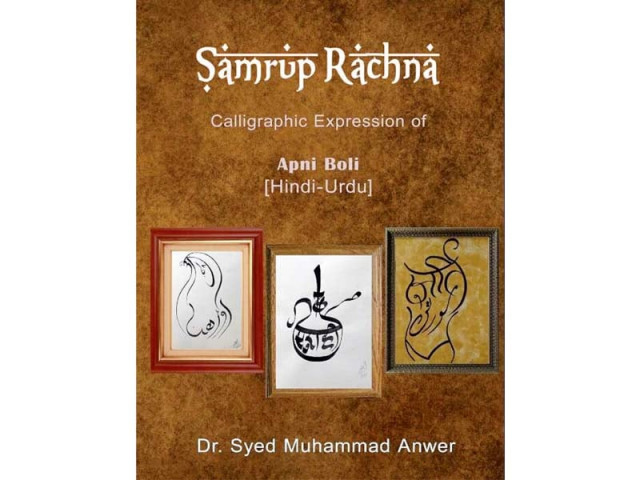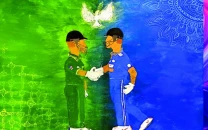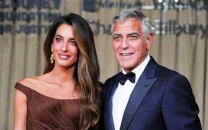Drawn from the same wellspring
Dr Syed Mohammad Anwer uses calligraphy to bring together Hindi, Urdu

Dr Syed Mohammad Anwer uses calligraphy to bring together Hindi, Urdu
Published by Wahdat Foundation, Islamabad, the hardcover publication is as much a coffee table book as it is a socio-political comment on the linguistic inheritance of the subcontinent.
At a very young age, Anwer was taught to read the Devanagari script by his mother, who had learnt it pre-Partition by observing her Hindu classmates. Even then, she was formally taught how to read in the Arabic script. The idea behind Anwer’s works was to illustrate that though Hindi and Urdu are written differently, they are essentially one spoken language.
Beyond the similarity of sound, they are spoken by people who share a culture, history and traditions. Nevertheless, one of these scripts is embraced and the other is actively rejected depending on which side of the Indo-Pak border you live in. This has deprived people of the shared literary heritage across the border. Anwer has used calligraphy to illustrate the union of Urdu and Hindi.
‘In private life, Jahangir was more like Akbar’
Samrup Rachna, a form of calligraphic art, is a creative way to paint a picture of the word that is written. Although the calligraphy itself is beautiful, the manner in which Anwer has used the script to create images on the page is truly astounding and fascinating.
The selection of words beginning with each phonetic sound is well thought out as Anwer has chosen concepts that resonate with both Hindi and Urdu speakers.
Synchronic digraphia – two writing systems for one language in the same era – is rare as one would imagine. The other modern day example is that of Serbian which can be written in either of two different alphabets, Cyrillic (like Russian) or Latin (like English). The implications for regional harmony are profound as making one written script entirely alien to a group limits access to information and the capacity for communication. To extend the idea, if we cease to associate one script with a religion, we would have the one language that we speak and in that sense the second largest language of the world as a spoken language.
Anwer has painted many religious terms that have seeped into everyday use. Words like fatwa and ashram are included in this collection, which have definite religious connotations, for Muslims and Hindus respectively, and yet are used extensively in both India and Pakistan. Anwer has used Samrup Rachna for certain religious words using pictorial representations that depict the essence behind the word. For instance, the word fatwa, has been written in the form of a dagger dripping blood.
Overall, this book is a recommended read. Even those who have no interest in the scripts themselves would enjoy having the book on their coffee tables so that they can flip through the pages and be enthralled by the curves and the lines of the calligraphy.
Title: Samrup Rachna — Calligraphic Expression of Apni Boli [Hindi-Urdu]
Author: Dr Syed Mohammad Anwer
Publisher: Wahdat Foundation
Price: Rs3,500
Pages: 134
The writer is a development consultant, freelance journalist and School of International Law director. She is interested in art, culture and music
Published in The Express Tribune, May 15th, 2016.
Like Life & Style on Facebook, follow @ETLifeandStyle on Twitter for the latest in fashion, gossip and entertainment.



















COMMENTS
Comments are moderated and generally will be posted if they are on-topic and not abusive.
For more information, please see our Comments FAQ